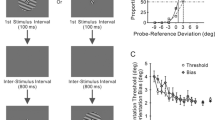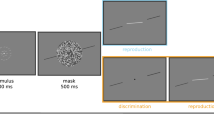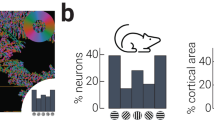Abstract
Sensory neural reorganization occurs as a result of visual experience in the adult as well as early in life. Here we report and quantify a misperception of visual orientation: when alphanumeric characters that are commonly tilted clockwise were presented with a clockwise tilt, they were perceived as less tilted than the same stimulus horizontally inverted. In contrast, subjective perception of tilt magnitude for horizontally inverted non-alphanumeric stimuli was similar to that for non-inverted stimuli. Therefore, misassessment of tilt of alphanumeric characters probably reflects a persistent sensory recalibration of orientation perception as a result of previous long-term visual experience.
Similar content being viewed by others
Main
Considerable evidence suggests that specific visual experience early in life can result in a reorganization of orientation selectivity among cortical neurons; for example, the rearing of animals in an environment containing a restricted range of orientations leads to a preponderance of cortical neurons tuned to that orientation1,2. In addition, sensory neural reorganization can also occur throughout adulthood3,4,5,6. Alphanumeric characters such as those used in digital displays and italicized text are commonly tilted clockwise by around 5–10°; therefore we asked whether long-term visual exposure to clockwise-tilted alphanumeric characters influences our visual perception of tilt.
We found that the tilt of clockwise-slanted characters appeared to be of much smaller magnitude than when such characters were horizontally inverted (as when viewed in a mirror; Fig. 1a and b ). To quantify this effect, we presented observers with stimuli consisting of three digits arranged side by side (888) and surrounded by a rectangular reference frame defining true vertical and horizontal. Stimuli were presented for 250 milliseconds twice—once with either a clockwise or counterclockwise reference tilt, and once with one of seven possible inverted comparison tilts. Both reference-tilt direction and the presentation order of reference and comparison were randomly interleaved. Observers were required to indicate which of the two trials produced the greatest impression of tilt. Reference tilts between 5° and 20° were investigated. As a control, the same observers were presented with non-alphanumeric stimuli using the same procedure. These consisted of three circular Gabor patches within which the sinusoidal luminance modulation was tilted either clockwise or counterclockwise. These stimuli were chosen because they are ideally suited to analysis by orientation- and frequency-selective mechanisms early in the visual cortex.
The horizontally inverted versions produce a greater impression of tilt. This effect is quantified in the experimental data (c). For each one of several clockwise (positive) and counterclockwise (negative) reference tilts, we plotted the mirror-image tilt that appears perceptually equivalent. Solid symbols, data for the alphanumeric characters; open symbols, data for Gabor patches (spatial frequency, 8 cycles per degree). Error bars represent s.e. The linear regression that best fits the data has the form y = 2.385 – 0.989x.
From responses averaged across six observers, we calculated the counterclockwise tilt that appeared perceptually equivalent to any given clockwise digit tilt, and vice versa ( Fig. 1c ). The diagonal dashed line represents the prediction that the matching tilt is exactly equal and opposite to the reference tilt. The control data for non-alphanumeric stimuli lie almost exactly on this diagonal line. In contrast, a best-fitting linear regression to the alphanumeric data has a gradient almost identical to that of the predicted function, but displays a constant error of approximately 2.4°. Thus, counterclockwise tilts are consistently perceived as more tilted than their clockwise counterparts, providing empirical support for the perceptual observations of Fig. 1a and b .
It is well established that perceived orientation can be influenced by previous adaptation to a tilted stimulus7. This is classically known as the tilt aftereffect, an illusion that decays rapidly over time8. The present findings, however, reflect a relatively persistent form of adaptation within the visual system, a phenomenon probably conditioned by extensive previous visual experience of alphanumeric characters whose tilt, if present, is almost always in a clockwise direction. Restriction of this misperception to alphanumeric characters implicates relatively high-level processes involved in character recognition. This kind of top-down regulation of perceived orientation receives considerable physiological support from dynamic changes in the orientation tuning of visual neurons via intracortical feedback mechanisms9. Our findings support the view that, in the sense that our everyday perceptions can be markedly influenced by unique prior visual experience, we learn to perceive. A robust test of this interpretation would be to establish whether the misperceptions we describe exist in cultures that provide little or no exposure to italicized Latin text or tilted digital numerals10.
References
Blakemore, C. & Cooper, G. F. Nature 228, 477–478 (1970).
Sengpiel, F., Stawinski, P. & Bonhoeffer, T. Nat. Neurosci. 2, 727– 732 (1999).
Merzenich, M. M. et al. J. Comp. Neurol. 224, 591– 605 (1984).
Gilbert, C. D. & Wiesel, T. N. Nature 356, 150–152 (1992).
Darian-Smith, C. & Gilbert, C. D. Nature 368, 737–740 (1994).
Gilbert, C. D., Das, A., Ito, M., Kapadia, M. & Westheimer, G. Proc. Natl. Acad. Sci. USA 93, 615–622 (1996).
Gibson, J. J. & Radner, M. J. Exp. Psychol. 20, 453–467 (1937).
Magnussen, S. & Johnsen, T. Vision Res. 26, 661–672 (1986).
Ringach, D. L., Hawken, M. J. & Shapley, R. Nature 387, 281– 284 (1997).
Segall, M. H., Campbell, D. T. & Herskovitz, M. J. Science 139, 769– 771 (1963).
Acknowledgements
P.V.M. was supported by a Vision Research Training Fellowship from the Wellcome Trust.
Author information
Authors and Affiliations
Corresponding author
Rights and permissions
About this article
Cite this article
Whitaker, D., McGraw, P. Long-term visual experience recalibrates human orientation perception . Nat Neurosci 3, 13 (2000). https://doi.org/10.1038/71088
Issue Date:
DOI: https://doi.org/10.1038/71088
This article is cited by
-
Individualistic weight perception from motion on a slope
Scientific Reports (2016)
-
A different angle
Nature (1999)




